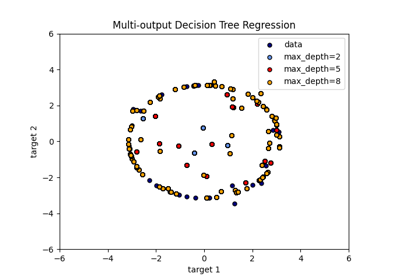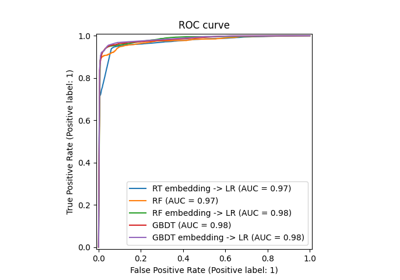Note
Go to the end to download the full example code. or to run this example in your browser via Binder
比较随机森林和多输出元估计器#
一个比较随机森林和多输出元估计器进行多输出回归的示例。
此示例展示了使用多输出元估计器进行多输出回归。这里使用了支持多输出回归的随机森林回归器,因此可以进行结果比较。
随机森林回归器只会预测在观测值范围内或更接近每个目标值零点的值。因此,预测结果会偏向圆心。
使用单一的基础特征,模型同时学习 x 和 y 坐标作为输出。

# 作者:scikit-learn 开发者
# SPDX-License-Identifier: BSD-3-Clause
import matplotlib.pyplot as plt
import numpy as np
from sklearn.ensemble import RandomForestRegressor
from sklearn.model_selection import train_test_split
from sklearn.multioutput import MultiOutputRegressor
# 创建一个随机数据集
rng = np.random.RandomState(1)
X = np.sort(200 * rng.rand(600, 1) - 100, axis=0)
y = np.array([np.pi * np.sin(X).ravel(), np.pi * np.cos(X).ravel()]).T
y += 0.5 - rng.rand(*y.shape)
X_train, X_test, y_train, y_test = train_test_split(
X, y, train_size=400, test_size=200, random_state=4
)
max_depth = 30
regr_multirf = MultiOutputRegressor(
RandomForestRegressor(n_estimators=100, max_depth=max_depth, random_state=0)
)
regr_multirf.fit(X_train, y_train)
regr_rf = RandomForestRegressor(n_estimators=100, max_depth=max_depth, random_state=2)
regr_rf.fit(X_train, y_train)
# 在新数据上进行预测
y_multirf = regr_multirf.predict(X_test)
y_rf = regr_rf.predict(X_test)
# Plot the results
plt.figure()
s = 50
a = 0.4
plt.scatter(
y_test[:, 0],
y_test[:, 1],
edgecolor="k",
c="navy",
s=s,
marker="s",
alpha=a,
label="Data",
)
plt.scatter(
y_multirf[:, 0],
y_multirf[:, 1],
edgecolor="k",
c="cornflowerblue",
s=s,
alpha=a,
label="Multi RF score=%.2f" % regr_multirf.score(X_test, y_test),
)
plt.scatter(
y_rf[:, 0],
y_rf[:, 1],
edgecolor="k",
c="c",
s=s,
marker="^",
alpha=a,
label="RF score=%.2f" % regr_rf.score(X_test, y_test),
)
plt.xlim([-6, 6])
plt.ylim([-6, 6])
plt.xlabel("target 1")
plt.ylabel("target 2")
plt.title("Comparing random forests and the multi-output meta estimator")
plt.legend()
plt.show()
Total running time of the script: (0 minutes 0.481 seconds)
Related examples





